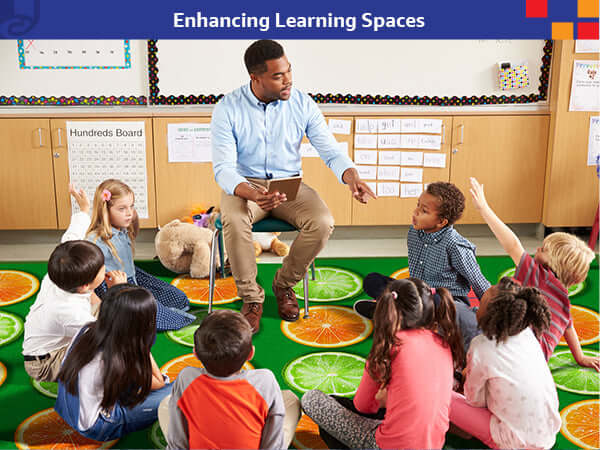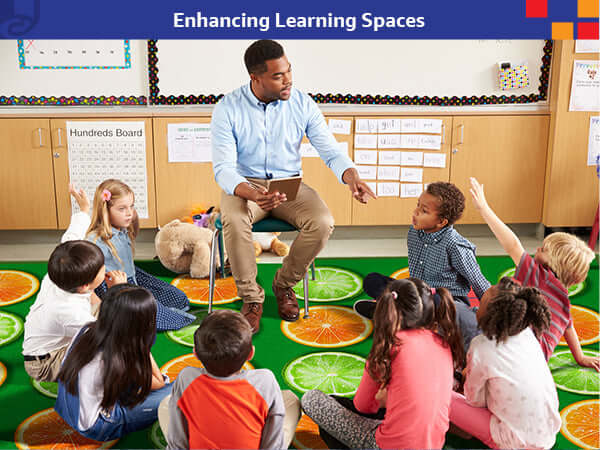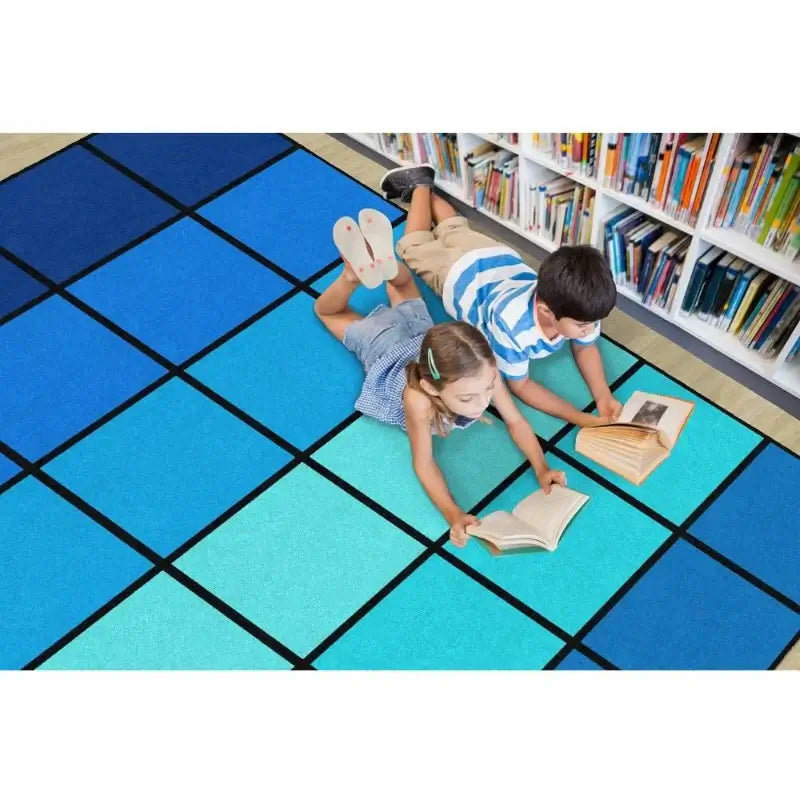G'day, classroom champions! Ever noticed how the most switched-on teachers seem to have that special magic when it comes to storytime? That's no accident! The secret often lies right beneath those criss-cross-applesauced little legs—a carefully chosen literacy classroom rug that transforms ordinary reading sessions into spellbinding literary adventures.
The Rug Revolution: Where Teacher Magic Happens
Let's face it—when Ms. Thompson asks the class to "find a spot on the reading rug," something shifts in the classroom atmosphere. Voices soften, wiggly bodies settle (mostly!), and eyes widen with anticipation. That special storytime rug isn't just a comfy spot—it's a psychological boundary that signals "we're entering the world of stories now."
"The moment I sit down on our reading tree rug with a book in my hands, it's like a switch flips in my classroom," shares Brisbane Year 1 teacher Emma Chen. "Even my most active little tackers seem to understand that this space has different expectations. The rug itself becomes part of our daily literacy ritual."
The Dance of Engagement: How Teachers Work Their Rug Magic
The most effective teachers don't just plonk themselves down and start reading—they choreograph the entire rug experience with intentional interactions that build literacy skills.
The Circle of Connection
Watch how Sydney kindergarten teacher Mark Williams uses his circular alphabet rug during morning reading:
"I always begin by having each child touch a letter on our rug that makes the sound we're learning that week," Mark explains. "Then I'll ask them to find something in our book cover that starts with that sound. Already, before I've read a single word, every child has made a physical and phonemic connection."
This tactile relationship with the rug creates a multisensory learning experience that simply doesn't happen at desks.
The Strategic Seating Shuffle
Melbourne prep teacher Jade Nguyen has elevated rug-based teaching to an art form with her "constellation seating" approach:
"I arrange children on our star-themed reading rug based on the specific skills we're targeting that day," Jade shares. "If we're working on making predictions, I'll pair prediction superstars with those who need more practice, positioning them on adjacent stars. During discussion time, they turn to their 'star buddy' to share ideas before we talk as a group."
This intentional use of the rug's design for strategic pairing means no child feels singled out, yet everyone gets the support they need.
The Whole-Body Literacy Experience
The magic really happens when teachers use the rug space for full-body engagement with text.
"On our word path rug, we physically act out story sequences," explains Adelaide Year 2 teacher Sam Thompson. "After reading 'We're Going on a Bear Hunt,' the children move from square to square retelling each part of the journey. They're squishing through mud, swishy-swashing through grass, and tip-toeing into the cave—all while following the narrative sequence on our rug path."
This kinesthetic connection to story structure helps children internalize narrative patterns that they'll later recognize in their independent reading.
The Teacher-Student Reading Bubble: Creating Magic Through Proximity
There's something extraordinarily powerful about the physical closeness that reading rugs facilitate. Unlike the separated spaces of desks and chairs, a quality classroom library rug creates what early childhood experts call "the intimacy bubble" for shared reading experiences.
"When I gather my preppies on our rainbow reading rug, I'm not just physically closer to them—I can use more subtle teaching techniques," explains Gold Coast teacher Olivia Parker. "I can whisper to create suspense, use facial expressions that everyone can see, and make quick real-time adjustments based on their responses. These micro-interactions simply don't work when children are spread across the classroom at tables."
This proximity allows for teaching moments that feel more like a family storytime than formal instruction—yet are packed with intentional literacy development.
Seven Brilliant Teacher Moves That Transform Rug Time into Literacy Gold
1. The Sound-Stepping Game
Perth phonics specialist James Wilson uses his phonics rug for a high-engagement sound blending activity:
"I'll ask students to physically step or hop from one sound to the next as we blend them together. For 'cat,' they'll jump to c-a-t on the rug while saying each sound, then they'll do a big jump while blending the whole word together. The physical movement helps cement the connection between individual sounds and complete words."
2. The Book-Walk Warm-Up
Before diving into a new story, experienced teachers know the value of the "picture walk"—but on a book-themed rug, this becomes even more engaging.
"I display our new book's cover on the smartboard, then ask students to 'walk' to the spot on our book rug that shows what they think the story might be about," shares Northern Territory teacher Lisa Chan. "Some will stand on characters, others on setting elements. Then I ask each child to explain their prediction based on where they're standing. It's a brilliant pre-reading comprehension strategy that gets everyone involved."
3. The Character Hot Seat
Tasmania's Teacher of the Year, Nina Martinez, transforms her circle time rug into a character analysis zone:
"We place a special chair in the center of our reading rug for the 'character hot seat.' After reading, students take turns sitting in the chair, speaking and answering questions as a character from our story. The physical shift from their spot on the rug to the central chair helps them mentally step into someone else's perspective—a crucial comprehension skill."
4. The Vocabulary Vaults
Classroom rugs can become physical dictionaries during reading sessions with this clever teacher technique:
"Our segmented rug has different colored sections," explains Brisbane vocabulary specialist Jordan Taylor. "When we encounter interesting new words during reading, I assign them to color zones on the rug. Later, during discussion, children move to the color that 'stores' the word they want to use in their response. It's a concrete way to track vocabulary growth and encourage word usage."
5. The Story Element Scavenger Hunt
Canberra teacher Mia Thompson uses her multi-section classroom rug to physically map out story elements:
"After reading, I place different colored cards in different rug sections—characters, setting, problem, solution. Children then draw or write elements from the story and move around the rug to place their contributions in the correct sections. The movement and collaboration make story structure analysis feel like a game rather than work."
6. The Prediction Pause Points
Strategic use of the rug space can transform how teachers handle prediction during reading:
"Our pathway rug has specific points where we always stop for predictions," shares Sydney reading specialist Alex Chen. "The students know that when I reach certain spots on the rug path while reading, it's time to predict what might happen next. These physical pause points help children internalize the natural places in stories where good readers make predictions."
7. The Retelling Relay
Adelaide teacher Sarah Johnson turns story retelling into a physical rug-based activity:
"After reading, we use our numbered rug spots for retelling relays. Each child sits on a number, and that's the page or part of the story they're responsible for retelling. We go in sequence around the rug, creating a complete collaborative retelling. The physical arrangement helps children understand that stories have a specific sequence and structure."
Creating Your Ultimate Literacy Rug Zone: Expert Teacher Tips
Ready to upgrade your classroom reading area? Here's how the pros create magical literacy spaces:
Location, Location, Location
"Position your reading corner rug away from high-traffic areas and distractions," advises Melbourne classroom design specialist Emma Wong. "Ideally, it should be in a corner where you can create a semi-enclosed feeling using bookshelves or room dividers. This spatial definition helps children mentally transition into 'reading mode' when they enter the space."
Comfort Creates Engagement
"A quality cushioned classroom rug makes a world of difference for wiggly bodies," notes Queensland early childhood expert Thomas Lee. "When children are physically comfortable, their brains can focus on the cognitive demands of literacy learning rather than discomfort. I've seen reading stamina double simply by upgrading to a well-padded rug."
Intentional Design Choices
The most effective teachers choose rugs that support their specific teaching style and literacy focus:
"I specifically selected our alphabet pathway rug because my teaching approach emphasizes the reading journey," explains Perth prep teacher Aisha Mahmoud. "We physically move along the letter path as we progress through our phonics program, giving children a visual and kinesthetic representation of their reading growth."
Beyond the ABCs: How Different Rugs Support Different Teaching Approaches
For the Phonics-Focused Classroom
Teachers who emphasize systematic phonics instruction often prefer letter-sound rugs with visual cues:
"Our phonics rug has letters paired with images—'a' with an apple, 'b' with a ball," explains Brisbane literacy specialist Tim Chen. "During our sound-of-the-day activities, I physically stand on that day's letter while introducing it. The children then move to stand on other rug sections that share the same sound. This physical sorting of sounds simply isn't possible with worksheet-based phonics."
For the Whole Language Enthusiast
Teachers who emphasize meaning and context find story element rugs support their approach:
"My reading rug has sections for characters, setting, and plot points," shares Sydney teacher Jessica Nguyen. "When I read aloud, I physically move to each section of the rug as those elements appear in the story. This movement helps children visualize the components that make up complete narratives."
For the Balanced Literacy Classroom
Many Australian teachers take a balanced approach, and their multi-purpose literacy rugs reflect this:
"Our classroom rug has both a letter border for phonics work and themed sections for comprehension activities," explains Melbourne educator David Thompson. "This allows me to use the same gathering space for both our explicit decoding lessons and our meaning-focused story explorations."
The Documented Difference: How Rug-Based Teaching Improves Outcomes
This isn't just about creating cute classroom spaces—research consistently shows that well-designed literacy environments impact learning outcomes.
A recent study across Queensland primary schools found that classrooms with dedicated, well-designed reading rug areas showed 23% higher engagement during literacy activities and significant improvements in reading attitudes among reluctant readers.
"We tracked reading behaviors before and after implementing our storytelling rug space," reports Adelaide principal Maya Johnson. "The data was clear—voluntary reading time increased, library book circulation went up, and teacher reports of active participation during reading discussions improved dramatically."
Real Teacher, Real Results: Transformation Stories
The Reluctant Reader Revival
"Cooper would hide under tables to avoid reading time," shares Gold Coast Year 1 teacher Sophia Martinez. "Everything changed when we got our adventure reading rug. The defined space and special 'reading captain' chair we placed on it gave structure to what had felt chaotic and threatening to him. Within weeks, he was volunteering to be our reading captain, proudly sitting on that special spot and attempting to read to the class."
The Classroom Culture Shift
"Our community circle rug completely transformed how my students interact with books," explains Darwin teacher Michael Lee. "Before, reading was something I asked them to do. Now, our special rug time has become something they ask for. They've developed their own rug reading rituals—the way they sit, the special voices we use for different characters, even the 'magic reading dust' we pretend to sprinkle before opening a new book. These student-created rituals show they've developed a reading culture, not just reading skills."
The Inclusive Reading Space
Perth special education teacher Olivia King found that a well-designed rug area became her most inclusive classroom space:
"Our sensory-friendly reading rug with its different textures has become the one place where every student, regardless of ability level, participates equally in literacy activities. The defined space, consistent routines, and tactile elements help my students with sensory processing challenges regulate themselves during reading time. It's the one activity where no accommodations are needed—the rug itself is the accommodation."
The Last Word: The Teacher Is the Real Magic
While we've explored how the right classroom literacy rug can transform teaching, veteran educators remind us of an important truth:
"The rug doesn't teach reading—teachers do," emphasizes Brisbane literacy coach Eleanor Wong. "The most beautiful, well-designed rug is just a floor covering until a skilled teacher brings it to life with thoughtful interactions, strategic teaching moves, and genuine reading joy."
That said, when those skilled teachers have the right environmental tools—like a quality literacy rug that supports their teaching style—the magic of reading comes alive in ways that transform young learners into lifelong readers.
So whether you're creating a cozy book nook for intimate guided reading groups or a grand storytelling circle for shared literary adventures, remember that the space you create sets the stage for the literacy magic that happens there.
After all, today they're sitting cross-legged on your classroom rug, eyes wide with wonder as you bring characters to life. But tomorrow? They'll be the ones weaving stories, reading worlds, and passing that same literacy magic on to the next generation.
And it all started with a teacher, a good book, and a special rug where reading feels like magic.








Leave a comment
This site is protected by hCaptcha and the hCaptcha Privacy Policy and Terms of Service apply.